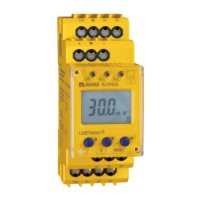Function
16
RCM420_D00057_03_M_ XXEN/03.2021
3.2.5 Functional faults
If an internal functional fault occurs, all three LEDs flash. An error code will ap-
pear on the display (E01…E32). In such a case please contact the Bender Ser-
vice.
3.2.6 Set the number of reload cycles
If faults occur only temporarily, but recurrently, in the system being monito-
red, with the fault memory M deactivated, the alarm relays would switch syn-
chronously to the error status.
RL in the out menu can be used to limit the number of these changeover pro-
cesses. As soon as the preset number of switching cycles is exceeded, the fault
memory will come on and an activated alarm remains stored.
3.2.7 Assigning alarm categories to alarm relays K1/K2
The alarm categories device error, residual current I
Δn1
, residual current I
Δn2
or
alarm by device test can be assigned to the alarm relays via the "out" menu.
3.2.8 Time delays t, t
on
and t
off
The times t, t
on
and t
off,
described below, delay the output of alarms via LEDs
and relays.
Starting delay t
After connection to the supply voltage, the alarm indication is delayed by the
preset time t (0…10 s).
Response delay t
on1/2
If the residual current increases above or falls below the response value the re-
sponse time t
an
expires. After the expiry of the response time an alarm is sig-
nalled. A set response delay t
on1/2
(0…10 s) adds up to the device-related
operating time t
ae
and delays alarm signalling (total delay time t
an
= t
ae
+ t
on
).
If the residual current fault changes from a value above the response value to
a value below the response value, an alarm will not be signalled.
Delay on release t
off

